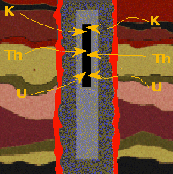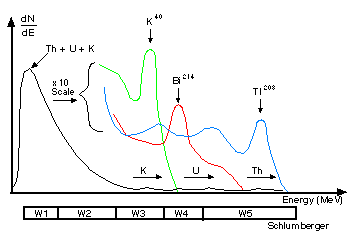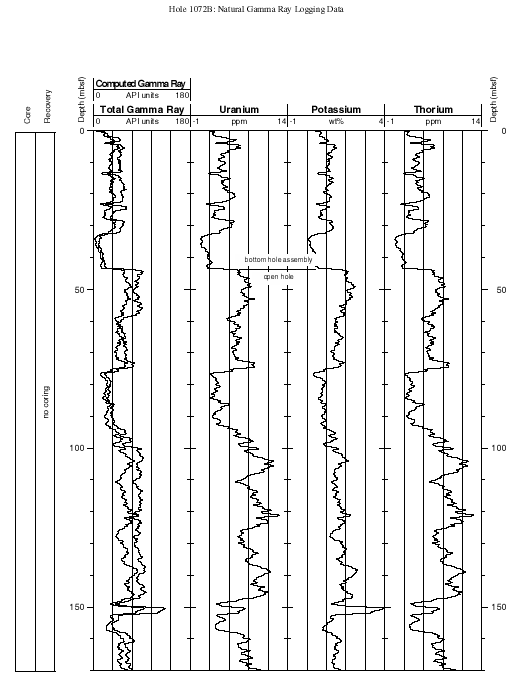Natural Gamma Ray Spectrometry Tool (NGT*)
Description
 The Natural Gamma Ray Tool (NGT) utilized a sodium-iodide scintillation detector to measure the natural gamma ray radiation of the the three most common components of the naturally occurring radiation: potassium, thorium, and uranium. The high-energy part of the spectrum was divided into three energy windows, each covering a characteristic peak of the three radioactivity series. The concentration of each component was determined from the count rates in each window. Because the high-energy region contains only 10% of the total spectrum count rates, the measurements were subject to large statistical variations, even using a low logging speed. The results were considerably improved by including the contribution from the low-energy part of the spectrum. Filtering techniques were used to further reduce the statistical noise by comparing and averaging counts at a certain depth with counts sampled just before and after. The final outputs were the total gamma ray, a uranium-free gamma ray measurement, and the concentrations of potassium, thorium, and uranium.
The Natural Gamma Ray Tool (NGT) utilized a sodium-iodide scintillation detector to measure the natural gamma ray radiation of the the three most common components of the naturally occurring radiation: potassium, thorium, and uranium. The high-energy part of the spectrum was divided into three energy windows, each covering a characteristic peak of the three radioactivity series. The concentration of each component was determined from the count rates in each window. Because the high-energy region contains only 10% of the total spectrum count rates, the measurements were subject to large statistical variations, even using a low logging speed. The results were considerably improved by including the contribution from the low-energy part of the spectrum. Filtering techniques were used to further reduce the statistical noise by comparing and averaging counts at a certain depth with counts sampled just before and after. The final outputs were the total gamma ray, a uranium-free gamma ray measurement, and the concentrations of potassium, thorium, and uranium.
The radius of investigation depended on several factors: hole size, mud density, formation bulk density (denser formations display a slightly lower radioactivity), and on the energy of the gamma rays; (a higher energy gamma ray can reach the detector from deeper in the formation). The vertical resolution on the log was about 1.5 ft (46 cm).
The NGT was deployed during DSDP Leg 95, throughout ODP, and on IODP Expedition 302. It was then replaced by the HNGS.
Applications
Clay typing. Potassium and thorium are the primary radioactive elements present in clays; because the result is sometimes ambiguous, itcan help combining these curves or the ratios of the radioactive elements with the photoelectric effect from the lithodensity tool.
Mineralogy. Carbonates usually display a low gamma signature; an increase in potassium can be related to an algal origin or to the presence of glauconite, while an increase in uranium is often associated with organic matter.
Ash Layer Detection. Thorium is frequently found in ash layers. The ratio of Th/U can also help detect these ash layers.
Environmental Effects
The NGT response was affected by borehole size, mud weight, and by the presence of bentonite or KCl in the mud. In ODP boreholes KCl was sometimes added to the mud to stabilize
freshwater clays which tend to swell and form bridges. This procedure took place before logging, and even though KCl was probably diluted by the time the tool reached total depth,
it could still affect the tool response. All of these effects wereaccounted for during the processing of the NGT data onshore.
Log Presentation
The NGT log was routinely recorded for correlation between logging runs. To this purpose SGR (total gamma ray in API units) and CGR (computed gamma ray – SGR minus Uranium component – in APIunits) were usually displayed along with other curves (resistivity, sonic, density etc.). A full display of the data with SGR, CGR, and THOR (in ppm), URAN (in ppm), and POTA (in wet wt %) was usually provided separately.
Tool Specifications
| Temperature rating: | 149° C (300° F) |
| Pressure rating: | 20 kpsi (138 MPa) |
| Diameter: | 3.625 in (9.21 cm) |
| Length: | 8.58 ft (2.61 m) |
| Sampling interval: | 6 in (15.24 cm) |
| Max. logging speed | 900 ft/hr (275 m/hr) |
| Depth of investigation | 1.5 ft (46 cm) |
Measurement Specifications
| Vertical resolution: | 0.75 to 1 ft (20 to 31 cm) |
| Depth of investigation | 1.5 ft (46 cm) |
Major Outputs
| SGR | Standard (Total) gamma ray (GAPI) |
| CGR | Corrected gamma ray (GAPI) |
| THOR | Thorium (ppm) |
| URAN | Uranium (ppm) |
| POTA | Potassium (dec. fraction) |
| W1NG | Window 1 (0.2 to 0.5 MEV) counts (cps) |
| W2NG | Window 2 (0.2 to 0.5 MEV) counts (cps) |
| W3NG | Window 3 (0.2 to 0.5 MEV) counts (cps) |
| W4NG | Window 4 (0.2 to 0.5 MEV) counts (cps) |
| W5NG | Window 5 (0.2 to 0.5 MEV) counts (cps) |
* ®trademark of Schlumberger

